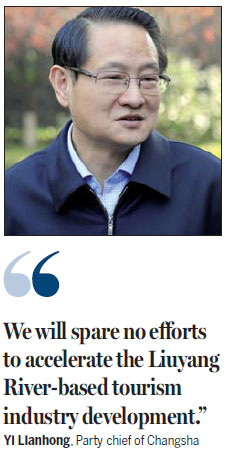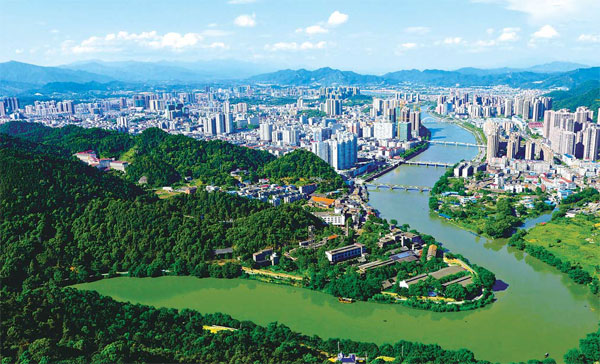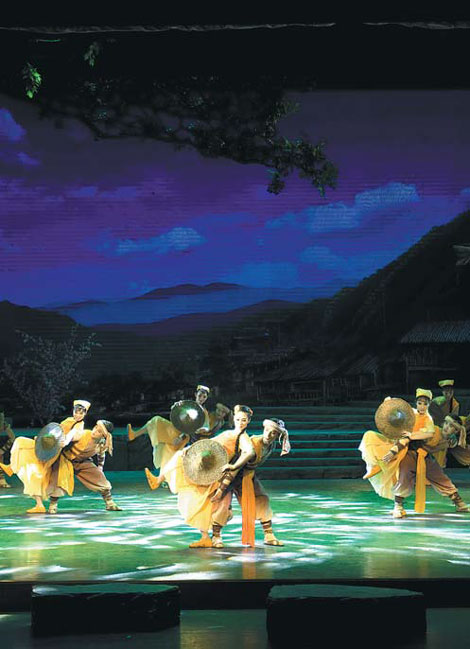Changsha plans tourism belt along Liuyang River
|
From left: The over 230-kilometer-long Liuyang River originates from Dawei Mountain and is one of the largest tributaries of the Xiangjiang River; A concert held in Changsha Musical Hall celebrates the end of the cultural festival on May 23; Professor Yuan Longping visits the Longping Rice Museum in Changsha. |
|
A popular tourist destination in China, Changsha in Hunan province aims to develop a world-class river-based tourism industry. Photos Provided to China Daily |
Unique culture and long history are leading attractions for area, Tang Zhihao reports.
Changsha, the capital city of Hunan province, plans to develop a world-class cultural and tourism belt along the Liuyang River to attract more visitors.
The belt, on which construction began in 2015, is designed to have similar features as the Seine River in Paris.
"We hope the Liuyang River will be an attractive tourist destination and can be developed into a landmark of Changsha," said Wang Huifang, chief engineer of the city's urban and rural planning bureau.
The river, which begins in Dawei Mountain in Hunan, is one of the largest tributaries of the Xiangjiang River.
It was widely known in China in the 1950s because of a song named Liuyang River.
However, the nation's cultural awareness of the river has declined in recent years.
Changsha released a Liuyang River culture and tourism industry upgrade plan aimed at boosting awareness of the river in April 2015.
According to the plan, Changsha, which plans to grow into a leading global tourism destination, will develop a world-class river-based tourism industry in the next few years.
"We will spare no efforts to accelerate the Liuyang River-based tourism industry development," said Yi Lianhong, a member of the Standing Committee of Hunan province and Party chief of Changsha.
Zhou Xiangzhi, an expert from the Hunan Academy of Social Sciences, said the Liuyang River plays a significant role in supporting Changsha's tourism industry development.

"A Liuyang River culture and tourism belt will strongly support Changsha's culture and economic development," Zhou said. "It will bring huge benefits to local residents."
Many national leading cultural and urban planning experts including scholar Yi Zhongtian, former president of Peking University Zhou Qifeng and architect Peng Peigen have participated in planning the project.
World-leading design concepts have been included in the project design.
Some tourism projects celebrated groundbreaking under the guidance of the Changsha government in 2015.
Five districts and counties along the Liuyang River, including county-level Liuyang city and Yuhua district, have provided strong support for the culture and tourism belt construction.
The city of Liuyang, which is in the upstream regions of the Liuyang River, plans to upgrade some of its famous tourism spots including the Dawei Mountain National Forest Park and Guandu Ancient Town.
The county government promised that none of the construction projects would have negative impacts on the local ecosystem. The Liuyang government has also paid great attention to tourism brand development in recent years.
The city is known for its flower blossoms in spring, rafting in summer, fruit harvest in autumn and skiing in winter.
The Liuyang River Music Festival and Liuyang River Firework Festival are popular with tourists. Changsha plans to continue to strengthen local folk culture promotion.
Officials from Chan town would become a key tourism destination in coming years. Jiangbei was a leading tile manufacturing base during the Yuan Dynasty (1271-1368) because it had a well-developed water transport system.
Historical relics discovered in the town suggest that people have been living along the Liuyang River since the New Stone Age.
The town of Tiaoma, Lituo subdistrict and Dongshan subdistrict in Yuhua district of Changshan are popular with tourists for their traditional cultural achievements and natural scenery.
Five key tourisms projects including the Tanyangzhou Wetland Park and Changsha Tombs of Princes of the Ming Dynasty Relic Park are under development in the region.
Furong district has served as the administrative center of Changsha since the Qin Dynasty (221-206 BC).
It is the home to the world-famous Mawangdui Han Tombs and the country of Machu in ancient China.
Furong has planned several projects including the Longping Rice Museum, Mawangdui Han Tombs Relic Park and Machu Relic Parks to display local culture and history. The Longping Rice Museum, which is the first rice-themed museum in China, opened in May.
The Liuyang River merges into the Xiangjiang River in Kaifu district in Changsha. The district has built museums, libraries and an urban planning exhibition center to strengthen its culture development.
The Yazipu community, one of the largest shantytowns in Kaifu, will be removed in the near future.
There will instead be a zone of culture and tourism that focuses on media, cultural innovation and leisure tourism in the district. Changsha will continue to strengthen Liuyang River ecological protection amid its rapid tourism industry development. The Changsha Urban and Rural Planning Bureau has developed detailed plans to protect the local ecology.
Contact the writer at tangzhihao@chinadaily.com.cn
|
Folk dance is one of the hidden treasures in Changsha, Hunan province. |
(China Daily 05/31/2016 page24)















